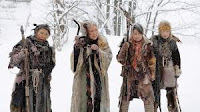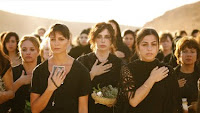 If you only see one film about elderly Japanese women bent on a bloody revenge mission, make it this one! Yes, Dendera ploughs its own furrow, turning an intriguing concept into a gory struggle.... against a bear.
If you only see one film about elderly Japanese women bent on a bloody revenge mission, make it this one! Yes, Dendera ploughs its own furrow, turning an intriguing concept into a gory struggle.... against a bear.Let me start again. Somewhere in a Japan where it is always snowing, village protocol dictates that residents who turn 70 are dumped on a mountainside and left to die. One woman, Mei, refuses to die and slowly builds up a women-only community--Dendera--out of those deemed expendable.
But, Mei's survival instinct is stoked by the burning injustice of being so callously discarded and she wants revenge on her former neighbours, especially the men who dictate policy. This may be an extended metaphor for modern society. Or it may be a needlessly explicit gorefest, as the women become distracted from their desire for vengeance by a bear that wanders into the camp and wreaks terror on it. Not out of any malign intent. But, rather because it's a bear and is hungry.
While it was great to see these women kicking ass, I just couldn't get into the bear hunt and was rooting for the poor creature to escape or join forces with the women. But, no. Lots of blood. Lots of chases. One character asks, "And who won?" Indeed.






